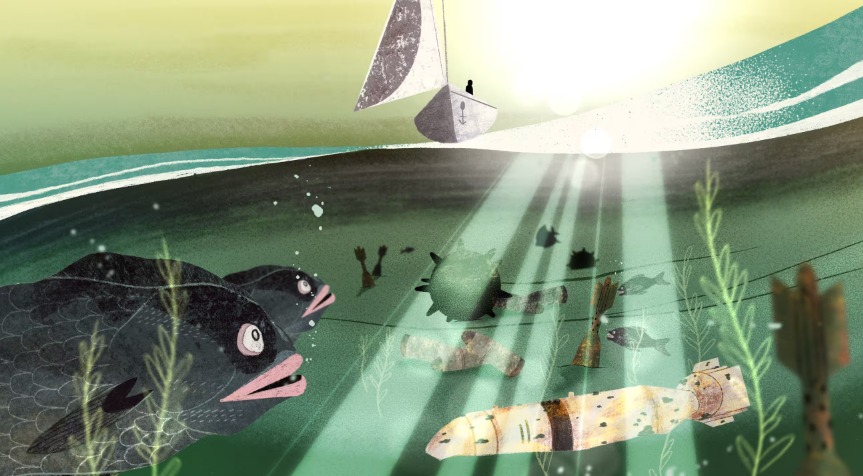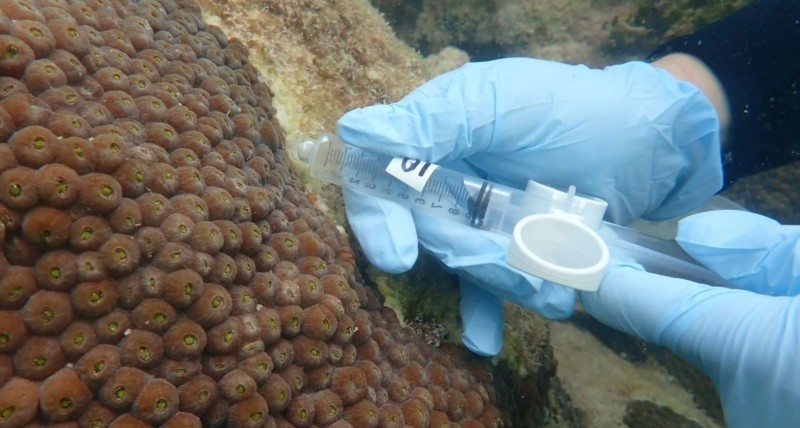The two world wars left behind hundreds of tons of unused chemical and conventional munitions (bombs, grenades, torpedoes). Since 1920, the French government has used the sea as a trash can to get rid of these toxic and dangerous weapons at a lower cost. But where exactly are these ammunition dumps located? In a new issue, broadcast Monday May 27 on France 5, the program “Vert de rage” attempts to reconstruct as precisely as possible the locations of these dumps, but also the proven presence of munitions or mines in the wrecks.
This inventory, which is not exhaustive, gives an idea of the extent of immersions, whether voluntary or not. To do this, data was collected from several sources: maritime charts from the Hydrographic and Oceanographic Service of the Navy (Shom), press archives, reports from the Oslo-Paris Commission. This international convention defines the terms of cooperation for the protection of the marine environment of the North-East Atlantic.
Some of these areas are well identified and protected by prohibitions on diving, swimming or navigation, established by maritime prefectures and indicated on maritime charts. But, in the absence of a precise census, other areas remain accessible to the public, potentially presenting a danger for fishermen and divers.
A practice that continued until 2002
As early as the 1920s, three methods of dumping at sea were used to dispose of munitions: scuttling ships to sink them; firecracking, which consisted of burying munitions to detonate them (this was particularly the case in the Bay of Somme); and the immersion of munitions, by plane, submarine or boat, in more or less deep places, and little frequented by boats, such as the Cape Levi trench (near Cherbourg) or that of the Casquets (north of Guernsey). This technique was the most widespread. “From 1998, the Navy substantially reduced the volumes concerned. At this period, the annual volume of explosive material was less than 10 tonnes per year,” explains the maritime prefecture, which ensures that the last operations took place four years later, in 2002.
“We threw them into areas that were not trawled, not worked by fishermen. At the time, we thought they would stay there, then disappear over time. »
Bertrand Sciboz, mine hunter
at franceinfo
Firecracking was practiced until April 30, 1997, the day of the fatal accident of the ship La Fidèle, reported by France Bleu. This French Navy boat had the mission of immersing 1,450 conventional grenades (representing 600 kg of explosives) off the coast of Cherbourg. The exact circumstances remain unclear, but some grenades reportedly exploded before being submerged, killing five people and injuring seventeen others. But, according to Bertrand Sciboz, a French underwater diver specializing in salvaging wrecks, although the number of munitions voluntarily dumped is significant, « the majority of munitions present in the underwater environment are located in bombed warships. » and shipwrecked.”
“An insoluble problem”
These immersions today pose two major risks for biodiversity: underwater explosions, which have the effect of an earthquake for fish, and the erosion of the metal sheaths protecting the munitions, which causes the leak of toxic substances. In the case of chemical munitions, mustard gas ends up diffusing into the seabed, infecting mollusks, algae, fish, and therefore the entire food chain. Today is a critical period since scientists estimate that it takes 80 to 100 years for an ammunition to finally become damaged.
The dissemination of these toxic components in the underwater environment also creates a chemical reaction which leads to hypoxia, an insufficient level of oxygen in the water, suffocating living organisms in the process, according to several studies carried out in the Mediterranean Sea. and in the Baltic Sea, known to be the largest dumping area in the world. “The problem is that today we do not have a technical solution to recover these chemical munitions,” explains Olivier Lepick, associate researcher at the Foundation for Strategic Research in Paris.
“It is likely that the remedy is worse than the disease: handling eroded munitions, which have been in the sea for decades, risks accelerating the dissemination of chemical agents in the water. »
Olivier Lepick, associate researcher at the Foundation for Strategic Research in Paris
at franceinfo
For so-called conventional munitions, several techniques exist, such as counter-mining, that is to say the destruction of weapons with other explosive charges. Operations are regularly carried out by maritime prefectures, such as in Plouguerneau (Finistère) in October 2023. “Countermining mainly concerns German mines which were the most dangerous and the most frequent,” explains Bertrand Sciboz. In certain cases, munitions can be “oceanized,” that is, moved to a deeper area, as was the case in Nouméa in May 2018.
Rates of explosive components never before observed
In addition to its census work, “Vert de rage” carried out, in partnership with researcher Aaron Beck, head of the Geomar working group, measurements of explosive components, such as TNT and its derivatives, including the toxicity is worrying. The team dived in Fouras (Charente-Maritime), above an explosives dump listed on nautical charts and prohibited for diving, where thousands of munitions from the First World War were submerged by the French army in the 1920s. Samples were also taken from a wreck located in the English Channel, near Courseulles (Calvados), reopened to diving after having been the subject of mine clearance operations.
Result: in Fouras, the levels of DANT, a molecule resulting from the degradation of TNT, reach 2,401 nanograms per liter (ng/L) in the water. This is the highest rate ever observed by the team of German researchers. TNT is potentially carcinogenic and suspected of harming fertility, as well as causing genetic malformations. Another sample showed 827 ng/L of tetryl, a toxic explosive used in the past, never before detected by researchers. Fouras sand contains up to 2,355 nanograms per kilo (ng/kg) of raw TNT. There are also significant levels of cobalt, nickel, arsenic and lead, which exceed environmental risk thresholds.
Same conclusion near Courseulles, where the contamination levels were similar to the rates observed in the Baltic Sea, where several thousand tons of conventional and chemical weapons were dumped. Residues of TNT and its derivatives, up to 242 ng/kg, were also found in the sand.
“A highly sensitive issue” for the authorities
To date, the exact number of submerged munitions is difficult to estimate and no official and exhaustive map exists, despite the promise of the Ministry of Ecological Transition to produce one. Last December, Patrice Vergriete, then Minister Delegate for Housing, affirmed that interministerial work, “spread over several years”, was underway, without specifying the timetable. Three years earlier, Annick Billon, centrist senator from Vendée, had asked a similar question to the government, and received exactly the same answer.
How can we explain the difficulty of the census? “These immersions were carried out by different services, in mainland France and overseas. The administration is so complex that it itself does not know where it has put these files,” argues Bertrand Sciboz. “The first immersions were carried out immediately after the First World War, without these operations necessarily being documented,” adds Olivier Lepick.
All existing data is therefore produced by international commissions such as the Ospar convention (Oslo-Paris) or by associations. According to Olivier Lepick, census work, even if not exhaustive, must certainly have been carried out by the Directorate General of Armaments (DGA) since the beginning of the 1990s. “The problem is that this data is not accessible to the public and even less published. » Indeed, France opposes defense secrecy to any question relating to the dumping of weapons at sea. Defense secrecy reinforced in 2008, under the presidency of Nicolas Sarkozy.
“It’s a highly sensitive question: which political leaders would be ready to recognize that France has engaged in such unacceptable behavior?,” continues Olivier Lepick. These immersions took place at a time when environmental sensitivity was very reduced, if not zero. » For its part, the dangerous nature of munitions (particularly chemical) does not encourage the authorities to disseminate overly precise information on the stocks and location of submerged weapons.




